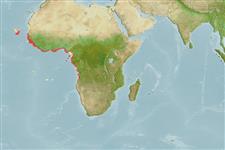Environment: milieu / climate zone / depth range / distribution range
Ökologie
seewasser; brackwasser demersal; tiefenbereich 5 - 200 m (Ref. 7345), usually 5 - 40 m (Ref. 27115). Tropical; 20°C - 25°C (Ref. 27115); 31°N - 15°S, 27°W - 14°E
Eastern Atlantic: from the coasts of Morocco to Angola (Ref. 3149); including Cape Verde archipelagos and the Canaries. Also recorded from southern Spain, Tunisia, Algeria, Israel and Greece (Ref. 112505).
Size / Gewicht / Alter
Maturity: Lm ? range ? - ? cm
Max length : 45.0 cm SL Männchen/unbestimmt; (Ref. 3148); common length : 38.0 cm SL Männchen/unbestimmt; (Ref. 3148)
Rückenflossenstacheln (insgesamt): 9; Rückenflossenweichstrahlen (insgesamt): 24-26; Afterflossenstacheln 6; Afterflossenweichstrahlen: 24 - 26. Caudal peduncle spine surrounded by a bright orange-yellow spot.
Coastal species found in the mouth of rivers and lagoons (Ref. 7345). Found on rocky and coral bottoms (Ref. 2683). Feeds on zooplankton, phytoplankton and detritus (Ref. 28587). Minimum depth reported from Ref. 27115.
Life cycle and mating behavior
Geschlechtsreife | Fortpflanzung | Ablaichen | Eier | Fecundity | Larven
Desoutter, M., 1990. Acanthuridae. p. 962-964. In J.C. Quero, J.C. Hureau, C. Karrer, A. Post and L. Saldanha (eds.) Check-list of the fishes of the eastern tropical Atlantic (CLOFETA). JNICT, Lisbon; SEI, Paris; and UNESCO, Paris. Vol. 2. (Ref. 7345)
IUCN Rote Liste Status (Ref. 130435)
Bedrohung für Menschen
Harmless
Nutzung durch Menschen
Fischereien: weniger kommerziell; Aquarium: Kommerziell
Mehr Information
NamenSynonymeMetabolismusRäuberÖkotoxikologieFortpflanzungGeschlechtsreifeAblaichenSpawning aggregationFecundityEierEientwicklung
ReferenzenAquakulturAquakultur ProfilZuchtlinienGenetikElectrophoresesVererbbarkeitKrankheitenVerarbeitungNutrientsMass conversion
Tools
Zusatzinformationen
Download XML
Internet Quellen
Estimates based on models
Preferred temperature (Ref.
123201): 21.9 - 28, mean 26.5 °C (based on 118 cells).
Phylogenetic diversity index (Ref.
82804): PD
50 = 0.5000 [Uniqueness, from 0.5 = low to 2.0 = high].
Bayesian length-weight: a=0.02188 (0.01279 - 0.03743), b=2.95 (2.81 - 3.09), in cm total length, based on LWR estimates for this species & Genus-body shape (Ref.
93245).
Trophic level (Ref.
69278): 2.5 ±0.24 se; based on food items.
Widerstandsfähigkeit (Ref.
120179): mittel, Verdopplung der Population dauert 1,4 - 4,4 Jahre. (Preliminary K or Fecundity.).
Fishing Vulnerability (Ref.
59153): Moderate vulnerability (42 of 100).
Climate Vulnerability (Ref.
125649): High to very high vulnerability (75 of 100).
Nutrients (Ref.
124155): Calcium = 111 [44, 405] mg/100g; Iron = 1.13 [0.44, 3.00] mg/100g; Protein = 17.7 [16.7, 18.8] %; Omega3 = 0.208 [0.090, 0.472] g/100g; Selenium = 36.1 [11.5, 135.0] μg/100g; VitaminA = 10.3 [3.2, 30.8] μg/100g; Zinc = 2.57 [0.84, 5.10] mg/100g (wet weight);
